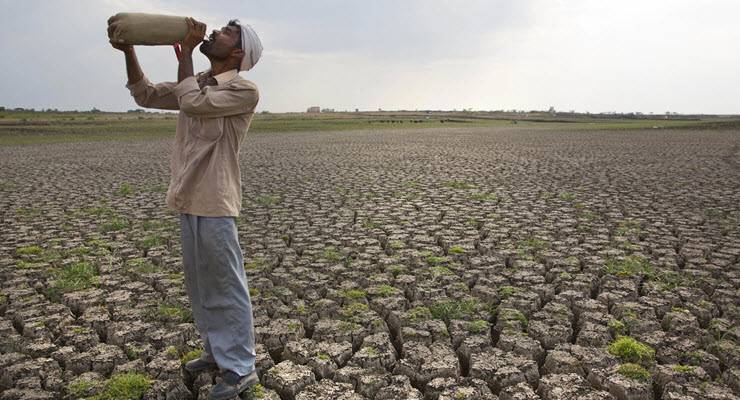
After several weeks of teasing Mumbai with scattered showers, India’s monsoon finally hit with a vengeance last Friday. Within hours, cars and the constant horn-honking conga-line of trademark black and yellow motorised rickshaws were ploughing through rapidly rising waters. The city’s roads, notoriously traffic clogged at the best of times, resembled half-submerged car parks.
At King Edward Memorial Hospital in the northern business district of Parel — a sprawling crumbling campus emblematic of the tatty stripped down services in the public health system — patients were forced to wade through 20cm-high water to get through the front gate and navigate additional ponds if venturing further afield.
The monsoon and the water it brings is at the epicentre of the country’s survival, being responsible for about 70% of India’s annual rainfall.
Despite all the water dumped across southern India over the weekend, the world’s second largest population and sixth biggest economy remains ravaged by drought. In the third week of June, official figures showed 46% of India was in drought. The country is facing a water crisis unparalleled in human history.
Major cities including the deep south’s major metropolis Chennai and technology hub Bangalore are all but out of water. A 2018 report by government think tank NITI Aayog predicts the same future for another 20 major cities within 20 years, including the capital Delhi. It’s a catastrophe that the think tank says will affect 600 million people. Yet all but only three states, a follow-up report found, have paid any attention.
The recent rains were particularly welcome in Mumbai, the capital of the state of Maharashtra that has been one of the worst hit by this year’s drought.
There are reports of entire villages being abandoned: residents flocking to already overcrowded cities, people walking for miles to queue for buckets of water, and livestock and crops being destroyed by dehydration. To make matters worse, states are battling over water and India itself is embroiled in fights over water resources with Pakistan and Bangladesh.
This year’s monsoon has been particularly late — just the latest sign that climate change is making the annual opening of the heavens increasingly unpredictable, and not just in India. It is the third major drought across significant parts of the country in four years and follows a significant drought only 12 months ago.
June rainfall figures released over the weekend underscore how slowly the monsoon is coming to its expected rescue with only a 33% rainfall deficit (compared to 118 year averages). Forecasters say this now means there is a 90% chance that July, India’s wettest month, would fall short, opening the way to an overall monsoon deficit for the third time in a decade.
Exacerbating India’s rapidly escalating water problem has been mismanagement of water resources, with Prime Minister Narendra Modi revealing last week that a pitiful 8% of India’s annual rainfall is captured. Yet critics say a landmark change in water policies after his 2015 election has only exacerbated this problem; the Modi government changed course from a long-term holistic plan of water conservation widely endorsed by water management experts to focus on more stop-gap solutions of farm irrigation.
Inadequate water reserves, supercharged by what is threatening to become a permanent state of dry season drought, has led to an alarming acceleration of farmers tapping into the earth’s natural underground water reserves. This has seen a dramatic lowering of the water table, with Resources Minister Gajendra Singh Shekhawat telling parliament last week that groundwater levels in 52% of monitored wells around the country were lower in 2018 than for the average over the preceding decade.
Not nearly enough has been done to shift farmers from water thirsty but high yielding crops such as rice, sugar cane and cotton. Moreover, farmers are increasingly taking their own lives, with over 20,000 suicides recorded since 2001.
The 2019 monsoon may have begun at last, but this year’s outlook continues to look bleak. “The precipitation outlook until September is within normal for most of India, with wetter than usual conditions foreseen in the central and eastern country, while to a lesser extent in the western and southern regions,” NGO Reliefweb noted. Despite this, “it is very unlikely that the multiannual cumulated deficits will be compensated by the incoming monsoon season”.
The increasing regularity and intensity of drought in India should not surprise Australians, who see the same thing happening around this country. But it is crimping an economy that continues to rise in importance to Australia; a 2018 report from former Department of Foreign Affairs and Trade chief Peter Varghese squarely targets India to be Australia’s number three trading partner by 2035 behind China and Japan.
As Australia’s economy is increasingly linked to Asia’s big three economies, their fortunes will be felt here as we have already seen with China. It’s not so much about demand for mineral and metal resources (which will continue to rise in India for the foreseeable future) but about the fortunes of Australia’s tourism sector, ever hostage to middle-class discretionary spending and the international education market.
India’s newly re-elected government knows it has a monumental problem, and it has promised action. But it has offered few answers so far. And while India is far from the only country facing an existential water crisis, it is the biggest nation where the threat looms closest. If serious answers are not explored immediately, there is real chance of a human and economic catastrophe that will rock the globe.








“The sooner they get our/Adani coal into ’em the sooner this will all go away” – see Limited News.
Welcome to capitalism, and its automatic abandonment of the needy.
Emissions in fact ceased to be the central issue three decades ago. Decades of denial has sacrificed the opportunity it once offered to avoid massive upheaval.
Abandonment is the default policy of capitalism for those damaged by AGW; our task is to force a change to ADAPTATION.
Adaptation is obviously what India needs, plus an effective government willing to govern for the masses instead of the moneybags. Lack of water is an immeduate stress. It highlights that reducing emissions is now simply a part of the massive research, planning and reconstruction effort required to allow our 24 million people to survive our continent becoming uninhabitable by current standards.
Class confrontation is inevitable. Climate change denial has two drivers. Firstly the awareness of the rich (one to which most of us are still asleep) that effective action requires the end of their class privileges and the hundreds of billions they loot from us every year just through tax and Budget giveaways. Secondly, that they can profit from our disasters.
Like our political class, India’s political class is clearly not interested in facing these issues. We need to calculate the extent of action by urgency, not the degree of lessening of denial. Nevertheless, denialists are to blame for their obstruction, so we should make sure that they are named and shamed – and blocked from any public position.
Population growth is always the answer. Lol
When the Raj left India it had a population of 390M – with 30M each in what became Pakistan & Bangla Desh.
India has since added over 1 billion, Pakistan is 210M & Bangla Desh 116M.
Rain & snow fall has steadily reduced as have the Himalayan glaciers which fed the great rivers – Indus, Brahmaputra, Ganges of the sub continent and of Asia – Salween, Mekong, Yangtze, and Huang Ho.
But no wucking forries, tek will fix everything and we can watch the Crapocalypse on our el-cheepo HD wide screens.
It really amazes me how stupid the greedy rich are, if the billionairs in India for example allowed some of their wealth to go to the poor the rising middle class would be an immense consumer of everything produced by those greedy bastards and everyone including them would benefit including the government with a massive boost to taxation revenues which could then be spent on infrastucture health and education which would again be an enormous benefit to all.
Humans are a plague species. We have destroyed many competing species and colonised a large number of species for our own ends but the usual fate of plague species is a massive population crash.
We are quite possibly staring down the barrel at that being not too far off. The rich and powerful may survive better than the rest of us and convince themselves that it wasn’t any fault of theirs / there was nothing they could have done about it but it is likely that they won’t escape the pain completely.
Maybe there is some justice in this blighted world we’re trying to hang on to.